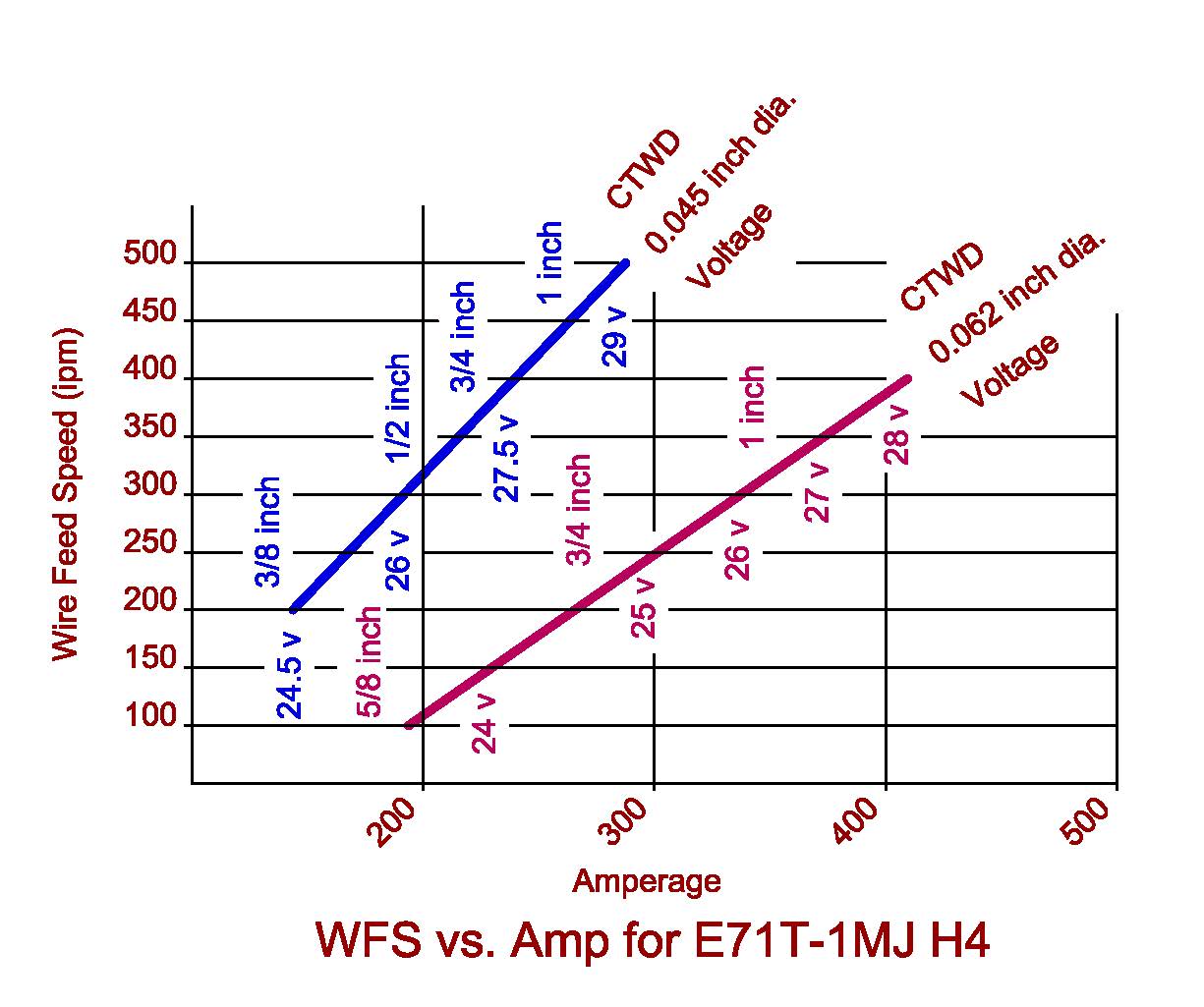
Hi Allan,
I apologize for posting a bit late on this topic of slope, inductance and Lawrence did provide a good link to Al's descriptions of the differences between Slope and inductance and how they relate to welding power sources of both Constant Current and Constant Voltage or Potential (CP) power source electrical output characteristics... On a side note: I am especially fond of inductance because of the name of the units of measurement for inductance being in "Henry's"


I just wanted to add a few links for anyone else who wants explore these topics as described by various reputable sources and I'll start with the first one from ESAB:
http://www.esabna.com/euweb/mig_handbook/592mig3_1.htm The Power Source
http://www.esabna.com/euweb/mig_handbook/592mig3_2.htm Voltage
http://www.esabna.com/euweb/mig_handbook/592mig3_3.htm Slope - part one of two
http://www.esabna.com/euweb/mig_handbook/592mig3_4.htm Slope - part two of two
http://www.esabna.com/euweb/mig_handbook/592mig3_5.htm Table 3-1
http://www.esabna.com/euweb/mig_handbook/592mig3_6.htm Inductance - part one of two
http://www.esabna.com/euweb/mig_handbook/592mig3_7.htm Inductance - part two of two
This is from the Lincoln Electric's MIG/MAG Welding Guide -Go to pages 8 through 11 in the book which would be pages 13 through 16 of this .pdf
http://www.locost7.info/files/tools/Lincoln+MIG+Welding+Guide.pdfThis is a pretty basic description of Slope and Inductance and how they relate to Short Circuit transfer in GMAW, or SCT published by The Fabricator:
http://www.thefabricator.com/article/arcwelding/choose-wisely-when-welding-thin-sheetP.S. As a bonus, if you look for table 1 in the article and click on the label, you will be linked to a reference chart that provides parameters for welding thin carbon steel and stainless steel...
I like this description also and is published by The Welding Advisors:
[b"]Slope Control
With reference to the standard graph expressing the relationship between current and voltage.
Constant Voltage power supplies would present a horizontal line or one of a limited slope down. This would be adequate for high current density and for Spray Arc.
When using small size wires and low currents, however, that is for Short Circuit Transfer Mode, there is a need to limit the amount of short-circuit current that the power supply can deliver.
A high short-circuit current generates a powerful "pinch-effect" or magnetic squeezing force that separates violently the molten drop from the wire.
If the short-circuit current is limited to a moderate value, by selecting a suitable slope, the detachment will be smooth with no or little spatter.
Note that if the slope is too steep, the current will be too low, and the unmelted electrode will stick to the work.Variable InductanceInductance control regulates the time rate of current change in response to changes in the circuit.
Adding some more inductance may prove beneficial in developing a more stable arc initiation.
One of the Mig-welding-tips that can have practical influence is the following.
In Short Circuit Transfer Mode inductance limits the pinch effect, which will be applied more gradually, by controlling the rate of current rise in time.
Higher inductance will decrease the number of short-circuits per second. The weld pool will become more fluid, resulting in smoother, flatter weld bead.
Too much inductance however will negatively affect arc initiation.
In Spray Transfer Mode, more inductance will only affect arc starts, which will result softer. No influence will be detected once the arc is running." I'm almost positive that Electrode has already seen this link from The Welding Institute of the UK (TWI):
http://www.twi-global.com/technical-knowledge/faqs/process-faqs/faq-what-does-inductance-do/Gas Metal Arc Welding Handbook, 5th Edition Page 28 & 29 - GW Online Textbooks provided by Goodheart - Willcox:
http://www.g-wonlinetextbooks.com/gas-metal-arc-welding-handbook-2008/28Quick questions and points to remember:
1.) What is the main purpose of "slope"? - To limit the short circuiting current so that spatter is reduced.
2.) What is the effect of too much slope? - Insufficient current to melt the wire off cleanly.
3.) What does inductance control? - The time rate of response for the current rise and fall.
4.) What effect does increasing and decreasing the inductance have on the weld? - Increasing inductance increases puddle fluidity, improves penetration, makes the bead flatter and smoother, and reduces spatter... To much inductance though will create erratic starts.
Slope:
The constant voltage power supplies used for GMAW are not truly constant in their voltage output because the voltage always drops some as the current (amperage) increases... This voltage to amperage relationship forms a slight curve when plotted as a graph... The general angle of the volt-ampere curve is known as the "slope..." This slope is adjustable on some power supplies... A flatter (more horizontal) slope is better for spray-arc welding, and a steeper slope is better for short-arc welding...
Inductance and Pinch Affect:
When using short-arc welding in GMAW, the current passing through the wire electrode heats and then melts the wire. This is sometimes called the pinch affect, because the molten wire appears to be pinched off, forming a droplet of molten metal... Low inductance produces high pinch affect, and high inductance produces low pinch affect. With low circuit inductance, the current rise is very fast, and the high pinch affect can cause the wire droplet to explode or spatter... When the circuit inductance is high, the current rises more slowly, decreasing the number of short circuits per second and extending the arc duration... The pinch affect forms the droplet more gently, which results in a more fluid puddle, smoother weld and less spatter...
Some inductance is also desirable in spray-arc mode, because it prevents explosive arc starts by slowing down the current rise rate. Many GMAW power supplies have a control to change the inductance and vary the pinch affect... Finally, here's a .pdf that might interest Electrode since it pertains to the previous thread that ended up with a very good discussion regarding some of the images that Electrode posted:
http://www.aws.org/wj/supplement/WJ_1971_11_s461.pdfOkay, I'm done... I hope this will help somebody.
Respectfully,
Henry








